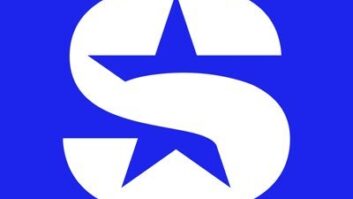Satellite maintenance work usually involves an analyzer or receiver of some sort, a length of cable and a stepladder to reach the low-noise block down-converter.
The LNB combines a low-noise amplifier, local oscillator and frequency mixer. It receives the microwave signal collected by the dish, amplifies it and down-converts the frequencies to a group of lower intermediate frequencies. This process permits the signals to be carried into the station using less-expensive coaxial cable. Expensive waveguide would be needed if the signal remained at its original microwave frequency.

Fig. 1: Route the satellite cable to a convenient mounting point for the feed-through.

Fig. 2: The completed satellite cable and feed-through are shown. Resetting a dish, or peaking it up after a windstorm, can be an involved process requiring the aforementioned equipment. Spirit Catholic Radio’s Mark Voris came up with an easier method.
As shown in Fig. 1, Mark cut the coaxial cable that led from the LNB. He located this cut under the dish in a location where it was easy to set up test equipment. This eliminates the need to balance equipment (and yourself) on a stepladder.
The process is simple. Purchase a female-to-female Type F connector, such as the Leviton QuickPort Feed through F Connector, available for less than $3 from Graybar (www.graybar.com). Make sure you turn off and unplug the receiver(s) so you don’t short out the DC signal traveling on the center conductor of the coax. Size a drill bit to fit the diameter of the feed-through, and drill a small hole in the supporting structure of the dish as shown in Fig. 1. Do not drill into the dish itself! Route the cable to the feed-through, cut it and install a male F connector on each end of the cable. The completed connector and cable assembly will look like Fig. 2.
Now, if adjustments need to be made, you can set the receiver or analyzer up behind the dish, at eye level, remove the cable going inside and screw your test cable into the feed through. Adjustments have never been easier — and safer, as you’re not balancing yourself and equipment on a stepladder.
Thanks Mark for a simple solution to a common problem.
****
While you’re behind your properly aligned satellite dish, grab a permanent marker and place marks on the adjusting bolts and screws.
The ink won’t affect the operation, but the marks will help you determine if the dish has been vandalized. If someone has cranked on adjusting screws and bolts, the marker indications will get you close to proper alignment.
****
It won’t be long until good weather reappears and brings another remote season with it. Remember to provide guests with a comfortable place to sit and watch the remote performance.
The problem with chairs is that it’s hard to keep them aligned and looking nice. If you provide folding chairs for your outdoor events, consider picking up a bag of small 5-inch wire ties. After all the chairs are placed in an orderly row, affix a wire tie to the top and bottom support of the chairs, locking them together.
Fig. 3 shows a close-up of the black wire tie on both the top and bottom support. Fig. 4 gives you an idea of how organized the audience area will be.


Fig. 3: You can tie upper and lower chair supports together using wire ties.Fig. 4: An organized row of chairs is held in place by the wire ties.
Tear-down is a breeze with a set of diagonal cutters. Bring along a small paper bag to collect the cut wire ties. If you station owns the chairs, assign an intern to identify the chairs with the station logo or call sign.
A slightly more expensive solution is to use 8-inch Velcro-brand hook-and-loop fasteners. These can be reused repeatedly and left affixed to one chair for the next event.
****
Among many products offered by Vero Tec Electronics Packaging is a neat fan tray. This 1RU assembly screws into a rack and positions six muffin fans above or below your equipment.
With temperature becoming a crucial consideration to rack-mounted equipment and card cages, the Fan Tray provides adequate cooling. The Fan Tray comes with a variety of options, such as filtration, AC or DC operation and thermostatic control.
For more information, search for “thermal solutions” at www.verotec.co.uk. The U.S. distributor can be reached via phone at (603) 821-9921.
Contribute to Workbench. You’ll help your fellow engineers, and qualify for SBE recertification credit. Send Workbench tips to [email protected]. Fax to (603) 472-4944.
Author John Bisset has spent 45 years in the broadcasting industry. He handles West Coast sales for the Telos Alliance. He is SBE certified and is a past recipient of the SBE’s Educator of the Year Award.












